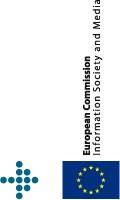 |
To evaluate the first year of the REACTION
project and plan for the next 6 months, project partners met
for the third REACTION Project Board Meeting on 21-23 March
2011, organised by partner IMM on their premises in Mainz.
Partners presented and discussed the technical
and scientific progress made which has resulted in the definition
of an initial architecture for the REACTION platform. Initial
prototypes and demonstrators were presented, including a concept
demonstrator for the primary care scenario, showing how devices
monitor different parameters, e.g. weight or blood pressure,
and immediately transmit the results to a server and, if necessary,
on to a health professional. For the in-hospital scenario,
a demo tablet was shown with functions for blood glucose management,
including clinical decision support and with connection to
the existing hospital system.
To ensure that the further development of
the platform and prototypes fits clinical practice, clinical
partners went through the necessary requirements for diabetes
management in primary care and in-hospital care. In primary
care, the focus is on preventing or delaying the typical progression
of the disease and the co-morbidities as a starting point
for managing the disease, supporting the patient and thus
preventing further complications. This calls for functions
such as patient education, feedback to patients and support,
dietary advice and connectivity to the Electronic Patient
Record. For diabetes care in the hospital, it is a matter
of keeping blood glucose levels within a certain range to
prevent hyperglycaemia and hypoglycaemia. To accomplish this,
it is essential that the staff is trained in the fundamentals
of glucose control. The current functions of the in-hospital
prototype include patient information, insulin dose, blood
glucose profile, administered insulin and therapy measures
but will also have to accommodate workflow management.
The activities for the next months will deal
with further developments of the prototypes based on updated
user requirements which emerge from clinical workshops and
experience.
A great deal of work has been done since
the partners last met, some of which is described in the deliverables
created and submitted during the last six months. These cover
disease management strategies and risk assessment tools, safety
issues in REACTION applications, health care economics and
reimbursements, validation framework and many more. The list
can be viewed on the project website and the public deliverables
downloaded.
/lbr/
to
the top  |
 |
 |
To create a vision for future diabetes care
using the REACTION platform, REACTION invited experts from
the healthcare domain and the ICT field to participate in
a one day scenario workshop in England. The focus was on the
uncertainties of disease management in the future.
Bernard Grossmann receives two messages on
his smart device, one reminding him to change his body sensor
and one inviting him to step onto the electronic scale. Bernhard’s
body sensor continuously monitors his blood pressure and blood
sugar and wearing it has become second nature to him.
The example is taken from one of the four
scenarios which were made in response to the question: How
do we perform chronic disease management and therapy using
intelligent networked medical devices in 2020 and beyond?
The aim of the scenario workshop was to envision how the REACTION
project could improve remote monitoring of diabetes and, in
the long term, support new care models and future clinical
workflows. The experts were asked to discuss possible influences
on chronic disease management based on a list of environmental
factors and the result was four plausible futures centred
on opposing elements: Proactive care versus conservative care
and cost-focused care versus patient-focused care.
Mastering the uncertainties of
the future
Scenario thinking is a method of providing
plausible futures built on the imagined interaction of key
trends in society. It is a useful method for identifying important
technological, security, socioeconomic and business drivers
that will shape the requirements of the future. Scenario thinking
does not predict the future. Instead it is built around the
uncertainties of the future and the development of new skills
that enable us to ask the right questions and look for missing
pieces to the puzzle; to spot unique opportunities and resolve
the uncertainties. This process will help determine the best
way forward.
Four plausible futures
After a complex process of mapping, manipulating
and rearranging thoughts, REACTION has developed four scenarios
which are equally likely to happen. Mixed with healthcare
trends, they focus on opposing elements: A proactive healthcare
system where prediction, prevention and integrated healthcare
are key factors and where patients are actively engaged in
defining their own care versus a conservative healthcare system
which fails to adapt to patients’ individual health needs
and problems. When it comes to focus on resources, the conflict
is between a patient-focused and publicly funded healthcare
where financial incentives are optimised and used to promote
healthy living and where ICT plays an important part and a
cost-focused situation characterised by cost effectiveness,
privately funded healthcare and a lack of support.
“The purpose of the workshop is to establish
long-term requirements, which support a full scale future
diabetes care model. In this future care model, we believe
inclusion and empowerment of the patient must be an essential
part. The scenarios will be used to investigate the consequences
of new technologies in terms of security and trust and it
will serve as a model for deriving user validation frameworks,”
says Jesper Thestrup from IN-JeT ApS, who has led the workshop
together with other partner representatives from Chorleywood
Health Centre and FORTH-ICS. The workshop took place at the
beginning of the project, April 2010.
/lbr/
to
the top  |
 |





